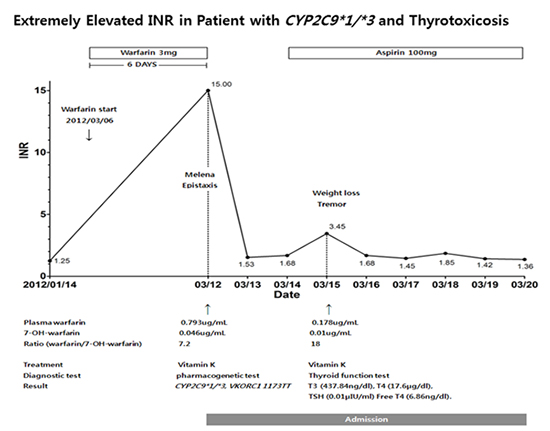1. Eriksson N, Wadelius M. Prediction of warfarin dose: why, when and how? Pharmacogenomics. 2012; 13:429–440.
2. Klein TE, Altman RB, Eriksson N, Gage BF, Kimmel SE, Lee MT, Limdi NA, Page D, Roden DM, Wagner MJ, et al. Estimation of the warfarin dose with clinical and pharmacogenetic data. N Engl J Med. 2009; 360:753–764.
3. Stuijver DJ, van Zaane B, Romualdi E, Brandjes DP, Gerdes VE, Squizzato A. The effect of hyperthyroidism on procoagulant, anticoagulant and fibrinolytic factors: a systematic review and meta-analysis. Thromb Haemost. 2012; 108:1077–1088.
4. Ma C, Zhang Y, Xu Q, Yang J, Zhang Y, Gao L, Xu B, Wang H, Li Y, Lu C, et al. Influence of warfarin dose-associated genotypes on the risk of hemorrhagic complications in Chinese patients on warfarin. Int J Hematol. 2012; 96:719–728.
5. Squizzato A, Romualdi E, Büller HR, Gerdes VE. Clinical review: thyroid dysfunction and effects on coagulation and fibrinolysis: a systematic review. J Clin Endocrinol Metab. 2007; 92:2415–2420.
6. Kurnik D, Loebstein R, Farfel Z, Ezra D, Halkin H, Olchovsky D. Complex drug-drug-disease interactions between amiodarone, warfarin, and the thyroid gland. Medicine (Baltimore). 2004; 83:107–113.
7. Self T, Weisburst M, Wooten E, Straughn A, Oliver J. Warfarin-induced hypoprothrombinemia. Potentiation by hyperthyroidism. JAMA. 1975; 231:1165–1166.
8. Vagenakis AG, Cote R, Miller ME, Braverman LE, Stohlman F Jr. Enhancement of warfarin-induced hypoprothrombinemia by thyrotoxicosis. Johns Hopkins Med J. 1972; 131:69–73.
9. Olchovsky D, Pines A, Zwas ST, Itzchak Y, Halkin H. Apathetic thyrotoxicosis due to hemorrhage into a hyperfunctioning thyroid nodule after excessive anticoagulation. South Med J. 1985; 78:609–611.
10. Tomisti L, Del Re M, Bartalena L, Tanda ML, Pucci A, Pambianco F, Danesi R, Braverman LE, Martino E, Bogazzi F. Effects of amiodarone, thyroid hormones and CYP2C9 and VKORC1 polymorphisms on warfarin metabolism: a review of the literature. Endocr Pract. 2013; 19:1043–1049.
11. Kellett HA, Sawers JS, Boulton FE, Cholerton S, Park BK, Toft AD. Problems of anticoagulation with warfarin in hyperthyroidism. Q J Med. 1986; 58:43–51.











 PDF
PDF ePub
ePub Citation
Citation Print
Print




 XML Download
XML Download